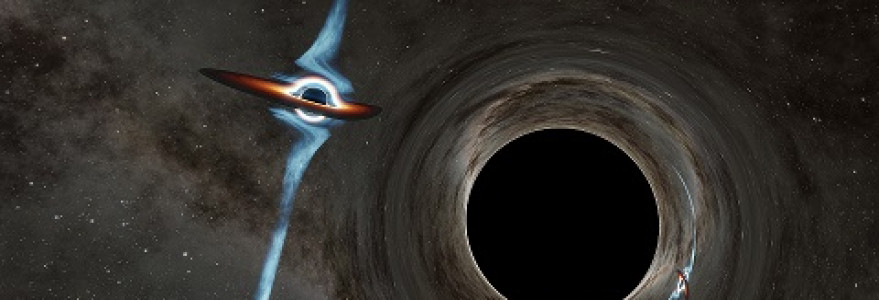Two supermassive black holes were discovered 9 billion light-years away, at the heart of the galaxy. The objects appear to be orbiting around each other every two years as if caught in a cosmic dance. Their spiral movement disturbs the fabric of space and time, sending out gravitational waves and decreasing the distance between the objects. In merely ten thousand years, the collision is expected to shake time and space.
An international team of astronomers has found evidence for a unique pair of supermassive black holes orbiting each other in the centre of a quasar called PKS 2131-021, nearly 9 billion light-years away. Two supermassive black holes, each hundreds of millions of times the mass of our sun, appear to be orbiting each other every two years. This epic cosmic spiral dance is a source of enormous gravitational waves while the distance between the black holes decreases rapidly. The titanic collision is expected when the pair merges in roughly 10,000 years,” describes Dr Przemysław Mróz from the Astronomical Observatory, University of Warsaw. The research results have been reported in The Astrophysical Journal Letters.
Powerful quasar jets
PKS 2131-021 belongs to a subclass of fiercely energetic quasars called blazars, in which a jet is pointing toward the Earth. Astronomers believe that the centre of each quasar is formed by an enormous black hole that creates a jet shooting out at the speed of light. “According to the study, a powerful jet emanating from one of the two black holes within PKS 2131-021 is shifting back and forth due to the pair’s orbital motion. This causes periodic changes in the quasar’s radio-light frequencies. Most quasars actually release electromagnetic radiation across the spectrum, all the way from x-rays to infrared,” explains the astronomer.
Changes in the brightness of the quasar
As the astronomer says, the periodic changes in the quasar’s radio-light frequencies have been registered by three different American radio observatories: Owens Valley Radio Observatory (OVRO), the University of Michigan Radio Astronomy Observatory (UMRAO), and Haystack Observatory. “When we realised that the quasar had been showing periodic variations for the past 45 years, we knew something very special was going on,” says Przemysław Mróz from the UW Astronomical Observatory, a co-author of the study who was responsible for mathematical modelling of the light curve of the quasar. “Quasars usually show stochastic variability, but this one has a nearly perfect sinusoidal light curve unlike anything observed from quasars before,” he adds.
Disturbance astronomical units apart
The PKS 2131-021 candidate black holes are about 2,000 astronomical units apart (an astronomical unit of length equal to the average distance between Earth and the Sun), and orbit each other every two years. For example, a comet about 2,000 astronomical units can take as long as 90,000 years to complete one trip around the Sun.
Astronomers believe that all galaxies are known to possess monstrous black holes at their cores, including the Milky Way galaxy. “When galaxies merge, their black holes ‘sink’ to the middle of the newly formed galaxy and eventually join together to form an even more massive black hole. As the black holes spiral toward each other, they increasingly disturb the fabric of space and time, sending out gravitational waves. Although this theory has not been proved yet, and no gravitational wave has been detected from any of the heavier sources, the discovery of the colossal black holes in PKS 2131-021 provides the most promising target ,” the astronomer says.
Gravitational waves from black holes
The LIGO and Virgo observatories, in which astronomers from the University of Warsaw are involved, were the first to directly detect gravitational waves. The supermassive black holes at the centre of PKS 2131-021 are millions to billions times the mass of our sun, and give off lower frequencies of gravitational waves that what LIGO and Virgo can detect. In the future, pulsar timing arrays, which consist of an array of pulsing dead stars precisely monitored by radio telescopes, should be able to detect the gravitational waves from supermassive black holes of this heft.
The discovery of the supermassive black holes in the PKS 2131-021 quasar should be proved within a couple of following years by rapidly spinning pulsars for very-low-frequency gravitational waves detection, such as: the European Pulsar Timing Array (EPTA), or the North American Nanohertz Observatory for Gravitational Waves (NANOGrav).
“We know a few confirmed binary supermassive black holes and the newly-discovered object is the tightest-knit supermassive black hole duo observed to date. This is an extremely exciting and unique object,” says Prof. Assist. Szymon Kozłowski from the UW Astronomical Observatory, who is an expert on quasar variability.



